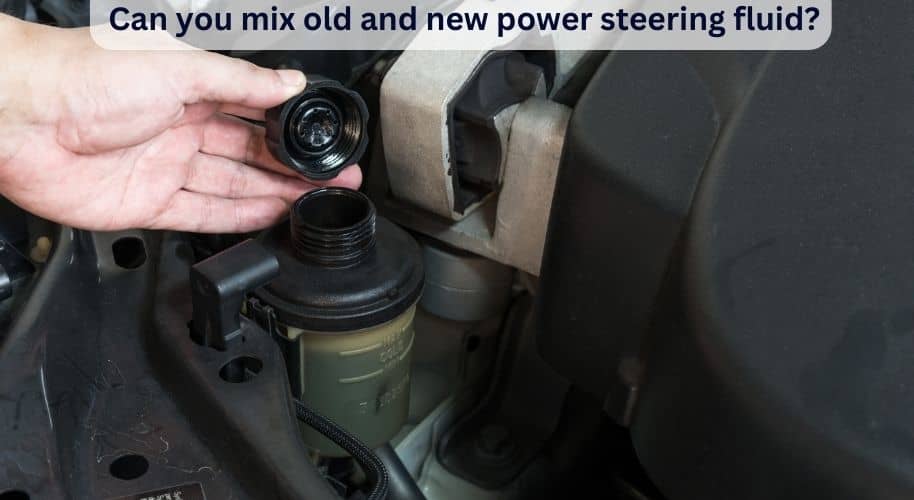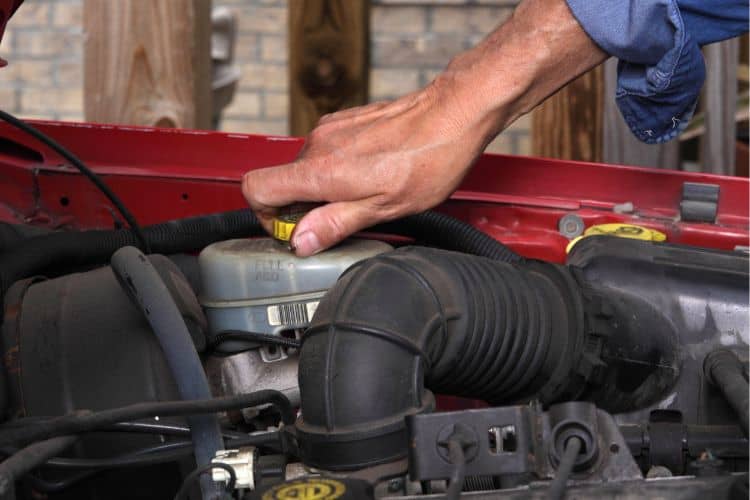Last Updated on March 14, 2023 by Henry T. Hawkins
Yes, it is possible to mix old and new power steering fluid. In fact, it may even be beneficial to do so! Combining the two fluid types can help maintain your car’s optimal power steering fluid levels. However, only mix fluids if your vehicle has a lower-than-normal power steering fluid.
In this article, we’ll explain why mixing old and new power steering fluid is okay, how to safely do so, and when you should avoid mixing the two. So, keep reading!

- What is Power Steering Fluid?
- Can you mix old and new power steering fluid?
- Do you have to drain old power steering fluid?
- What are the symptoms of old power steering fluid?
- Benefits of mixing old and new fluids
- Disadvantages of mixing old and new fluids
- How to check power steering fluid levels?
- Wrapping Up
What is Power Steering Fluid?
Power steering fluid is a type of hydraulic fluid used in the power steering system of a modern vehicle to create a hydraulic link between the steering wheel and the front wheels. This allows for easier steering, particularly at lower speeds.
The fluid also lubricates the electric motor parts within the steering system, protecting against wear and corrosion. Regular checking and maintaining the hydraulic power steering fluid level is essential. It can ensure the proper functionality of the power steering system.
Can you mix old and new power steering fluid?
Yes, you can mix old and new power steering fluids. Doing so can help maintain the proper power steering fluid level in your vehicle, but it’s important only to mix the fluids when your car is low on power steering fluid. Too many air bubbles can cause problems for the system.
This ensures that you keep the levels healthy without having to drain out all the old fluid. We recommend checking the vehicle manual for the correct type of power steering fluid.
“If you are topping up the fluid level, it is safe to mix old and new power steering fluids. However, if the existing power steering fluid is significantly degraded and needs replacing, use only new or manufacturer-approved power steering fluid to replace it,” says Shayne Spurling, Automotive Mechanic at Delta Car Care Inc.
Do you have to drain old power steering fluid?
Always flush the power steering fluid every 40,000-80,000 miles for optimal performance. However, keep in mind that manufacturer recommendations may vary.
The flush routine may also vary depending on the type of vehicle. Regularly check the power steering fluid level and have a professional mechanic inspect the system for leaks or other issues.
Drain the old power steering fluid as part of the flush process, but only as per the manufacturer’s recommendations. Using the wrong type of fluid can damage the power system.
Also read: How do you know if your steering stabilizer is bad
What are the symptoms of old power steering fluid?
There are several symptoms that may indicate that the power steering fluid in a vehicle is old or dirty and needs to be replaced. Some of these symptoms include:
Whining or squealing noise when turning the steering wheel
This can indicate that the fluid is low or contaminated. Before starting the engine, ensure the VW hydraulic power steering fluid reservoir is filled.
The steering wheel is hard to turn
Old or dirty fluid can cause the power steering system to become less efficient, making it harder to turn the steering wheel.
Steering wheel vibrates or shakes
This can be caused by worn or damaged steering components that are not lubricated properly by the power steering fluid.
Leaking power steering fluid
If you notice a puddle of fluid under your car, it could signal a leak in the power steering system. So drain the power fluid before driving and use the correct type fluid.
Warning light on the dashboard
Some vehicles have a warning light that indicates low or dirty power steering fluid.
Benefits of mixing old and new fluids
Mixing old and new power steering fluid can have several advantages. Here is the benefit of steering fluid:
Extending the life of the fluid
Mixing old and new fluid can help extend the fluid’s life, as it can help dilute any contaminants or debris present in the old fluid.
Improving the performance of the system
Mixing old and new fluid can help to improve the performance of the power steering system, as the new fluid can help to lubricate and clean the system, making it easier to steer the vehicle.
Cost-effective
It can be a cost-effective solution when you mix old and new fluid, as it is not necessary to replace all the fluid when it is low but rather to top it off with new fluid. It will save you from costly repairs.
Disadvantages of mixing old and new fluids
When topping off power steering fluid with a mix of old and new fluids, there are potential drawbacks to consider:
Reduced effectiveness of new fluid
If the old power steering liquid is contaminated or degraded, it can reduce the effectiveness of the new fluid and make it less efficient.
Mismatch in fluid properties
Mixing different fluid types may result in a mismatch of fluid properties, leading to damage to the power steering system or reduced performance. There are other power fluid options for certain types of vehicles.
Difficulty in determining the correct fluid level
Combining different types of fluid can make it difficult to determine the correct hydraulic power steering fluid level, which could lead to overfilling or underfilling of the system.
Possibility of introducing new contaminants
Mixing different types of fluid can introduce new contaminants into the system, which could lead to damage or reduced performance.
Difficulty in Diagnose
Combining different types of fluid can make it difficult to diagnose problems with the power steering system, as the presence of new fluid may mask the symptoms of wear and tear.
Also read: Can you reuse a spare tire
How to check power steering fluid levels?

Checking a vehicle’s power steering fluid level is a relatively simple process. Here are the general steps to follow:
Locate the power steering fluid reservoir
The power steering fluid reservoir is typically located in the engine compartment near the power steering pump. The reservoir is typically marked with a “PS” or “Power Steering” label on most types of vehicles.
Check the fluid level
The power steering fluid level should be between the “Min” and “Max” marks on the side of the reservoir. Check the fluid pressure; if the level is low, add fluid as necessary.
Check the fluid color and consistency
The power steering fluid should be a clear, reddish color. If the fluid is dark or discolored, it may be contaminated and need replacement.
Check for leaks
Look around the power steering pump, high-pressure hose, and connections for any power steering leak or signs of wear or damage.
Check the owner’s manual
Always refer to the vehicle’s owner manual for specific instructions, as the location and process of checking the power steering fluid level might vary depending on the make and model of the vehicle. Most modern cars now use synthetic fluid.
Also read: Can you polish wrapped cars
Wrapping Up
You can mix old and new power steering fluid in your car. This will help maintain the correct amount of fluid and keep your power steering system functioning properly.
Be sure to check the vehicle manual for the recommended power steering fluid type and consult a professional mechanic before making any changes to the fluid.
Remember, regular maintenance of your power steering system is crucial to ensuring your vehicle’s longevity and smooth operation.
Please share this valuable information with your friends and family so they also benefit from this and keep their vehicles running smoothly.
